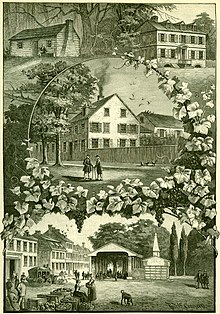Germantown (Philadelphia)

Germantown is a neighborhood in Philadelphia in the Upper Northwest district . It was originally an independent city ( township ), which was incorporated into the city of Philadelphia in 1854. The original name of the Pennsylvania Dutch is Deitscheschteddel 'Deutschestädtlein' .
origin
In 1683, Germantown was founded, initiated by Franz Daniel Pastorius , after the first closed group of German settlers arrived in North America on the Concord ship . The group consisted of 13 Quaker and Mennonite families from the Krefeld area, the so-called " Original 13 ".
On February 18, 1688, four Germantown residents, Franz Daniel Pastorius, Abraham Isacks op den Graeff , Herman Isacks op den Graeff and Gerrit Henderich initiated the first protest against slavery in America .
The first paper mill based on the European model was founded in Germantown in 1690 by William Rittenhouse .
In 1721 the German pastor Antonius Jacobus Henckel founded the first Lutheran church in Germantown. Henckel worked here until his death on August 12, 1728. He was buried in the cemetery of St. Michael's Lutheran Church in Germantown. In 1917 his descendants erected a memorial stone in the churchyard.
The Battle of Germantown took place near Germantown during the American War of Independence on October 4, 1777 , in which the Continental Army was defeated by British troops, but this defeat enabled the decisive victory at Saratoga a few days later.
The Swedish traveler Pehr Kalm wrote about the settlement in the middle of the 18th century:
“Germantown is six miles from Philadelphia. This place has only one street but is nearly two miles long. It is mostly inhabited by Germans who come to North America from their homeland and settle there because they enjoy rights here that they do not have anywhere else. Most of the inhabitants are artisans who produce almost everything in such quantity and excellent quality that this province will need very little from England in a short time. "
present
As a result of the Great Migration , more and more Afro-Americans moved to Germantown and many Germantown and Irish people left the area in the 1960s. The vast majority of the population today are African American.
Sons and Daughters of Germantown
- Wilhelm Rettinghaus (1644–1708), first paper manufacturer in North America
- David Rittenhouse (1732–1796), astronomer and mathematician and first director of the United States Mint
- Louisa May Alcott (1832–1888), writer
- Frederick Winslow Taylor (1856–1915), engineer and ergonomist
- Owen Wister (1860-1938), writer
- Joseph Clark (1861–1956), tennis player
- Ross Granville Harrison (1870-1959), zoologist
- Walter Brown Gibson (1897–1985), journalist, writer and magician
- Thomas S. Gates (1906–1983), Secretary of State for the Navy and Secretary of Defense
- Francis Schaeffer (1912–1984), theologian, particularly influential as an apologist
- Sarai Sherman (1922–2013), painter and sculptor
- Dennis Vincent Durning (1923–2002), Roman Catholic Bishop of Arusha
- Maxine Kumin (1925-2014), poet
- Grace Kelly (1929–1982), actress and future Princess of Monaco
- Henry Gibson (1935–2009), actor
- Jef Lee Johnson (1958-2013), guitarist and singer
- Mike Mentzer (1951-2001), body builder
- Eric Lobron (* 1960), German chess master of American descent
- Amanda Blank (* 1983), musician
Other personalities
- Alexander Mack (1679–1735), German emigrant, founder of the Schwarzenau Brethren
- Johann Christoph Sauer (1695–1757), German emigrant, first Bible printer in North America
See also
literature
- Armin M. Brandt: Build your altar on a foreign earth. The Germans in America - 300 Years of Germantown. Seewald Verlag, Stuttgart 1983.
- Jens Roepstorff: Germantown. Mülheim emigrants in America. Mülheimer Jahrbuch 2005, pp. 215–222.
- Robert F. Ulle: The Original Germantown Families . In: Mennonite Family History . tape 2 , no. 2 , April 1983, ISSN 0730-5214 , p. 48-51 (English).
- Bernd Brunner: To America. The history of German emigration. CH Beck, ISBN 978-3-406-59184-6 .
Individual evidence
- ↑ the-independent-friend.de, rp-online: "Krefelder Protest gegen Sklaverei", June 24, 2009, by Olaf Radicke, online article
- ↑ (en) Protest against slavery
- ^ Matthew J. Countryman: Up South. Civil Rights and Black Power in Philadelphia. University of Pennsylvania Press, Philadelphia 2006, ISBN 0-8122-3894-X , p. 72.
Web links
- Web pages Describing Historic German Town (English)
- Art by Joseph Ropes (1812-1885), Scene in Germantown, Pa. , 1874
- Art by Anna Peale Sellers (1824–1905), Belfield Farm (near Germantown)
- Art by William Britton, Market Square, Germantown , c. 1820
- Greater Germantown Housing Development Corporation ( Memento from November 29, 2010 in the Internet Archive )
- East Germantown Blight Certification , City Planning Commission, 2003 (PDF file; 260 kB)
- Phillyhistory.org (English), Historic Photographs of Philadelphia, City Archives
Coordinates: 40 ° 3 ′ N , 75 ° 11 ′ W

